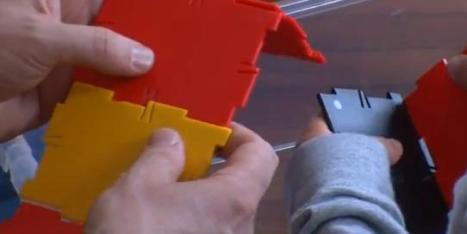The last time I hosted Math Teachers at Play I attempted to start a tradition of including a math puzzle pertinent to the number of the carnival. Alas, it didn’t take, but now that I’m hosting again I can mention an old classic:
Three people check into a hotel. They pay $30 to the manager and go to their room. The manager finds out that the room rate is $25 and gives $5 to the bellboy to return. On the way to the room the bellboy reasons that $5 would be difficult to share among three people so he pockets $2 and gives $1 to each person.
Now each person paid $10 and got back $1. So they paid $9 each, totaling $27. The bellboy has $2, totaling $29.
Where is the remaining dollar?
If you’re a teacher, here’s a meta-question: can you generalize the errors made in the puzzle? Can you give a textbook, not-designed-as-a-puzzle example where this happens?
Teaching

Ryan at Maths at SBHS ran a lesson using a segment from the show Community, and wants to know how to make it better.
John Golden ruminates about resources for elementary level homeschooling.
Pat Ballew writes about The Marginal Economics of a Kindergarten Education — how much is an education really worth?
Research demonstrating misunderstanding of the equal sign has been in the news lately. Maria Miller takes up the case.
Meanwhile, David Wetzel wants to eliminate elementary student math misconceptions.
Lisa Suben has her students making 3D figures out of pipe cleaners.
Should we be discouraging young students from finger counting? Caroline Mukisa examines the debate.
Mark Graybil ponders the choice between Java and Javascript in classes the require programming.
Learning

Pat Ballew reaches to this category as well with an “Almost Pythaogrean” relationship.
Sue VanHattum posts a video from the Richmond math salon, which she describes as “A monthly math festival in my living room.”
Whit Ford gives advice for students to learn the game of learning.
Scott Palat also reminds students to get help when needed.
Guillermo Bautista has an excellent way of making sense of exponential growth.
Denise at Let’s Play Math has an equally excellent introduction to probability.
Eldon Sarte provides “An account of exactly when I realized that a good education can make all the difference in the world.”
John Cook finds Three surprises with bc, which is as he describes “an arbitrary precision calculator with only five basic math functions. This post explains how to bootstrap these functions to do everything you’d expect from a calculator.”
Last but not least, Sol Lederman wants to share a “very interesting and simple trick to impress your friends” involving 12 pennies.
And that’s a wrap! Math Teachers at Play #30 comes next month to JD2718.
Filed under: Education, Mathematics |


[…] August 23, 2010 tags: MTaP, Number Warrior by Denise After a slight delay, the new Math Teachers at Play carnival is up at The Number Warrior, with a nice variety of blog posts to browse. Enjoy! The last time I […]
[…] Math Teachers at Play 29 […]
[…] else are you going to access your data from the web on your computer? Math Teachers at Play #29 https://numberwarrior.wordpress.com/2010/08/23/math-teachers-at-play-29/ Who doesn’t like to have fun in Math class? This post links to other posts featuring some fun […]
[…] Posts and Reminders August 25, 2010 Guillermo Bautista Leave a comment Go to comments Math Teacher’s at Play #29, the Let’s Play Math blog carnival, has been posted via The Number Warrior. The Carnival […]
[…] at The Number Warrior recently posted about the nefarious bell boy who causes hotel guests to lose a dollar: Three people […]
Jason, I love your questions, but I don’t know how to answer them…
I’m going to give it some more time and post about it myself if nobody else does.
[…] A special “thank you” goes to this post source (link at end of post). Head on over to Math Teachers At Play #29 carnival to read a nice assortment of posts on math […]
They paid $9 each, which is $27. The hotel owner has $25 and the bellboy has $2. 25+2=27. Add in the 1+1+1 the bellboy returned to the travelers and you get the original $30 paid out. No money is missing.
The error comes from adding the busboy’s sum to the amount paid out. The busboy’s money doesn’t come *in addition* to what the travelers paid – he took *part* of what they paid. So it’s the common error of not knowing which operations to use for a word problem.
I don’t know how to write it as a textbook problem that would result in the same confusion, though, because the wording of the puzzle intentionally provides misdirection and makes it harder to solve. I can’t think of an objective way of writing it that would induce the same mistake.
[…] Math Teachers at Play #29 […]
[…] and there is latitude for quite a bit more. Look at the previous edition, #29. […]
[…] Last month’s Math Teachers at Play […]
[…] you really miss the “Discuss the number” feature, go visit the previous edition, MTaP #29, where Jason shared a 29/30 puzzle right up […]
[…] examples for inspiration. The blog connects well to other sites, through Math Teachers at Play contributions. (Written by an Arizona high school math teacher, who’s on sabbatical to create a […]
[…] Jason Dyer (@jdyer) hosted #29. […]